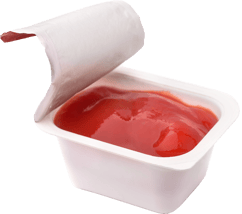 As pressure to achieve improved sustainability & recyclability in food packaging continues to mount, organizations across the value chain must innovate packaging solutions to keep up with the changing consumer demands and increasing legislation. Food processors and industry stakeholders are responding by setting goals and targets to make all packaging recyclable or compostable (in some cases by 2025) through the elimination and replacement of problematic materials with more sustainable alternatives. In tandem, companies are now being compelled through regulations like Extended Producer Responsibility and government taxation policies to move forward with material replacement.
As pressure to achieve improved sustainability & recyclability in food packaging continues to mount, organizations across the value chain must innovate packaging solutions to keep up with the changing consumer demands and increasing legislation. Food processors and industry stakeholders are responding by setting goals and targets to make all packaging recyclable or compostable (in some cases by 2025) through the elimination and replacement of problematic materials with more sustainable alternatives. In tandem, companies are now being compelled through regulations like Extended Producer Responsibility and government taxation policies to move forward with material replacement.
However, the complex nature of food packaging & sterilization systems & processes, along with stringent food safety and preservation specifications makes this task easier said than done. This leaves room for new product development and innovation on the materials side to meet evolving sustainability requirements while maintaining other critical specifications including processing, cost and packaging function.
Innovative materials are playing a crucial role in advancing sustainability and circularity for plastics packaging. These materials not only reduce the environmental impact of plastic packaging but, when designed properly, promote a circular economy by enabling the recovery and reuse of packaging materials. We understand the important role that material innovation plays in helping the industry achieve their sustainability and circular economy goals and have made it a cornerstone of our product development philosophy.
However, while we understand that the development of sustainable packaging solutions is an industry-wide priority, we also understand that this cannot be considered in a vacuum. In reality there are a variety of challenges that processors must solve for in addition to sustainability that cannot be ignored if a solution is going to be brought to market. More importantly, solutions cannot create more problems than they solve - which is where our team's experience comes in.
Understanding the long list of requirements that organizations must meet from a processing and performance perspective, our team set out to develop a portfolio of solutions that "check all the boxes," elevating sustainability while creating an opportunity for organizations to increase their competitive advantage. ICPG's philosophy is centered around the idea of creating products that not only answer the needs and challenges of our customers but push the industry forward in a positive way.
Below are some of the new projects that our team is working on to unlock industry-wide access to innovative materials and scale circular solutions:
Breaking New Barriers with Mono-Polymer Material Structures
 The worldwide push for sustainability and accountability is driving a shift in the packaging industry, forcing brand owners and converters to find more sustainable alternatives to commonly used barrier food packaging materials such as, HIPS/PVDC, PET/EVOH and even some PP/EVOH/PE structures.
The worldwide push for sustainability and accountability is driving a shift in the packaging industry, forcing brand owners and converters to find more sustainable alternatives to commonly used barrier food packaging materials such as, HIPS/PVDC, PET/EVOH and even some PP/EVOH/PE structures.
While these structures have historically offered excellent barrier performance and product protection, the complex mix of materials presents a challenge from a recycling perspective. However, specifications for product protection cannot be ignored.
Our revolutionary XPP with patent-pending Resource Efficient Barrier Alternative (RE-BA) reimagines barrier packaging technology to deliver a simplified mono-polymer, sustainable and recyclable solution, all while providing similar OTR barrier properties to EVOH & PVDC in thin-gauge applications including PC condiment cups, PC creamer cups, case-ready & deli meats, snack packs and more. When combined with our XPP Polypropylene solutions, this innovation provides an effective replacement for traditional barrier rollstock structures using combinations of HIPS/PVDC, PS/EVOH and PP/EVOH/PP structures allowing for replacement of problematic materials using existing thermoforming & form-fill-seal equipment.
Synchronizing Sustainability and Cost Savings
Sustainability & economics have historically been at odds, but our XPP Polypropylene solutions boast enhancements to key performance attributes allowing sustainability & cost savings to coexist.
An example of this is through increased yield and reduced material consumption. A key feature of our XPP Polypropylene Solutions is enhanced stiffness, resulting in an improved flex modulus of 400,000 - 500,00 PSI compared 300,000 PSI for PS, 425,00 PSI for PET and 175,000 - 275,000 PSI for traditional polypropylene depending on the grade.
This results in a material that behaves similarly to PS & PET in thermoforming and form-fill-seal allowing for processing on existing equipment and tooling with minimal setting adjustments, equipment modifications and no loss in cycle-times or through-put. As a polypropylene-based structure, the reduced density also results in a 12% yield advantage vs PS and a 30% yield advantage vs PET, resulting in a more efficient use of resources and cost savings:
1,000,000 lbs PP = 1,120,000 lbs PS
1,000,000 PP = 1,300,000 lbs PET
This enhanced stiffness also presents an opportunity to down-gauge existing polypropylene structures. Down-gauging is a commonly used method in the extrusion-thermoforming & form-fill-seal industries in which the gauge or thickness of the rollstock structure is decreased to reduce material consumption, improve sustainability and control cost. Typically there are limitations regarding how much the material structure can be down-gauged before seeing reduced performance or failure in the thermoformed part. However, the enhanced stiffness of our XPP solutions allows for increased down-gauging of existing polypropylene structures without compromise to part performance. Initial testing has shown a 10-15% weight reduction is achievable with a down-gauged XPP structure.
This down-gauged structure can be processed using existing tooling, without sacrifice to part performance - all while significantly reducing material consumption and improving sustainability at a cost savings. ICPG is conducting experiments to further explore and evaluate the potential impact on material consumption and opportunities for replacement of existing structures in thermoformed containers made from traditional PP.
Strategic Collaborations that Scale Circular Solutions:
The importance of product development and innovation cannot be overstated when it comes to improving the sustainability of plastic food packaging. With the growing concern over plastic waste and its impact on the environment, it is crucial for companies to explore new ways to create packaging that is not only functional and aesthetically pleasing but also eco-friendly. This requires a commitment to research and development, as well as a willingness to embrace new technologies and materials through strategic collaborations with organizations across the value chain.
ICPG understands that this is a tough challenge to tackle alone, and are actively seeking out partnerships to license our product innovations for replacement of problematic materials with more recycle-friendly, mono-polymer PP solutions and help the industry get closer to achieving its goals of a plastics circular economy.
Want to get involved? Contact our team to learn more about ICPG's material solutions and partnership opportunities:




